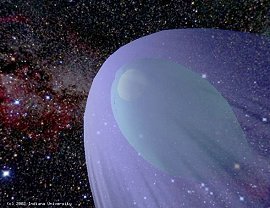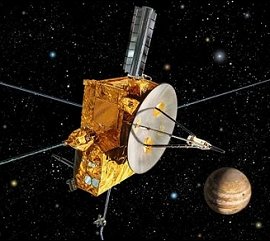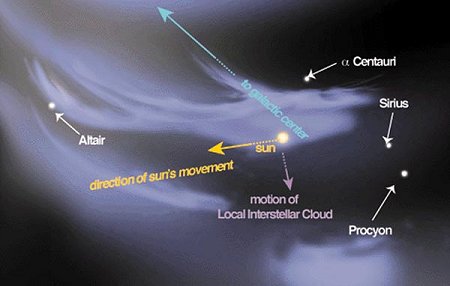|
A breeze of interstellar helium atoms is blowing through
the solar system.
by Dr Tony Phillips
If you've ever watched
Star Trek, you know the importance of shields. When a star
explodes or a Klingon death ray lances out of the darkness, the
captain yells two words, "Shields up!", and all is well. Deflector
shields: Don't leave home without one.
The solar system, believe
it or not, has got one.
The solar system's
deflector shield is a giant magnetic bubble called "the heliosphere."
It's part of the sun's magnetic field. No one knows the precise
dimensions of the heliosphere, but it's bigger than the orbit of
Pluto. All nine planets are inside it.
The heliosphere is
important to life on our planet. A few million years ago, for instance,
a cluster of massive stars drifted through our part of the Milky
Way and exploded, one after another, like popcorn. Cosmic rays from
the blasts were mostly deflected, sparing early humanoids a radiation
bath.

An
artist's concept of the heliosphere
|
But the bubble isn't
perfect. The fact is, "it's leaky," says space scientist Eberhard
Moebius of the University of New Hampshire. "Some things do get
through." (This happens on Star Trek, too. If the ship's
shields were impenetrable, there would never be any drama.)
Take cosmic rays for
example. They are fragments of atoms shattered and accelerated to
light speed by supernova blasts. The heliosphere deflects about
90% of them; the rest, the most powerful 10%, penetrate the inner
solar system.
The bubble is even
more vulnerable to particles with no electric charge. Magnetic fields
can deflect charged particles like cosmic rays, but not neutral
atoms and molecules or bits of dust and rock. The bubble is an open
door to these.
To wit: a stream of
neutral helium atoms - "an interstellar breeze," says Moebius - is
flowing into the solar system right now. "It's coming from the direction
of the constellation Sagittarius. Because the atoms in the stream
are uncharged, the magnetic bubble does nothing to stop them."
Studying this stream
is important because it can teach us a great deal about the heliosphere - How
big is it? How leaky is it? It can also teach us about the interstellar
"stuff" lurking just outside, says Moebius.

The
Ulysses spacecraft, illustrated here, is crucial to the
helium stream research because its GAS instrument can
directly sample the flow.
|
The stream, discovered
30 years ago, is actively monitored by a flotilla of NASA and European
Space Agency spacecraft: SOHO, EUVE, ACE and, especially, Ulysses.
Each measures something different. EUVE, for instance, can sense
ultraviolet sunlight scattered from the stream, while Ulysses samples
the stream itself, snatching atoms directly from the flow.
For many years the
physical characteristics of the stream were only vaguely known.
"But the ability we have now to take a close-up look at the stream
using these modern spacecraft has made a difference," says Moebius.
He recently led a research team at the
International Space Science Institute in Switzerland; using data
from the spacecraft they were able to pinpoint the stream's temperature,
density and velocity:
Its temperature, 6000
C, is about the same as the surface temperature of the sun. A spacecraft
flying through the stream won't melt, though, or even notice the
heat. The gas in the stream is too wispy-thin, explains Moebius.
"There are only 0.015 helium atoms per cubic centimeter." Earth's
atmosphere at sea level, for comparison, is a thousand billion billion
(1021) times denser. And, finally, the velocity of the
stream is 26 km/s or 58,000 mph.
These numbers confirm
what astronomers have long suspected. The solar system is colliding
with a vast interstellar cloud.
Most people think space
is empty, but it's not. The "void" between the stars is crowded
with clouds of gas. Clouds on Earth are miles wide. Clouds in space
are light years across. They range in character from inky-black
and cold to colorful and glowing-hot. Stars are born in clouds,
and they hurl even more clouds into space when they die. Interstellar
clouds are everywhere, so it's no surprise that the solar system
is running into one.

The local interstellar cloud
|
The question is, what
kind of cloud?
This cloud, like most
things in the Universe, consists mainly of hydrogen. We know this
because the hydrogen absorbs telltale colors from the light of nearby
stars. Astronomers use this absorption effect to trace the cloud's
general outline: it is several light years wide and ragged-edged.
The cloud's abundant
hydrogen doesn't easily penetrate the heliosphere because hydrogen
atoms in the cloud are ionized by interstellar ultraviolet radiation.
Like cosmic rays the hydrogen atoms are charged and, thus, held
at bay. Helium atoms, on the other hand, are mostly neutral, so
they slip into the solar system.
Although helium is
only a minor ingredient of the cloud, it tells the researchers what
the whole is like. The cloud's temperature is 6000 C, the same as
the helium stream. Its velocity, 26 km/s, is the same, too. If the
cloud contains a standard cosmic mix of hydrogen and helium - a reasonable
assumption - then its overall density must be 0.264 atoms per cubic
centimeter.
Arcania? Not at all.
These numbers are important.
They are vital to the size and "leakiness" of the heliosphere. The
bubble is inflated from the inside by the solar wind and compressed
on the outside by the cloud. It's a balancing act. If the pressure
of the cloud (a function of temperature, density and velocity) is
high, it defeats the solar wind and makes the bubble smaller, lowering
our defenses against cosmic rays.
Thousands of years
from now, some researchers believe, the solar system will pass completely
through this cloud and emerge in a low-pressure cavity blown by
those supernovas a few million years ago. The heliosphere will expand,
providing improved protection against cosmic rays.
After that … who knows?
Another cloud might come along compress the bubble again. The ISSI
team's research, eventually, could tell us how the heliosphere will
react.
Shields up? Shields
down? It's not science fiction any more.
|
